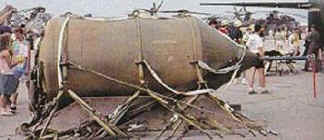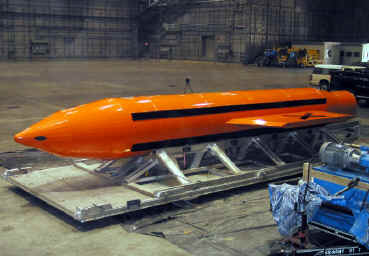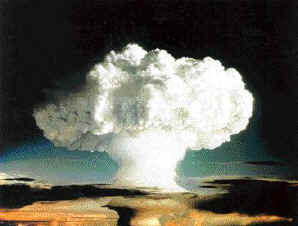After nuclear bombs were developed, improvements to the explosive power of conventional bombs ended. Billons of dollars were spent to make nuclear weapons smaller, safer, and more powerful. Although nuclear weapons have not been used since 1945, research into more powerful conventional bombs is rare. During World War II, the Barnes Wallis “Tallboy” (12,000 lb) and “Grand Slam” (22,000 lb) bombs were used by the British. Although the RAF could never lift them to the design release height of 40,000 feet, and so had to release at approximately 25,000 feet, the “Tallboy” could still go through 16 feet of concrete, or if dropped into earth create an 80 ft. deep crater some 100 ft. across. Additionally, one of the prime objectives of the bomb was to produce a localized earthquake effect, thus creating damage far in excess of that obvious from the size of the crater.
 The largest conventional bomb used during the Vietnam and Iraq wars was the BLU-82 15,000
lb bomb (left). These contain a GSX explosive
slurry, and are dropped out the back of C-130 cargo planes. BLU-82s were used
in Vietnam to create instant landing zones in jungle areas, hence the nickname "daisy
cutters."
A little known historical fact is the South Vietnamese Air Force used C-130 Hercules
to drop BLU-82s and break up a multi-division assault on Xuan Loc outside Saigon in 1972. During
Operation DESERT STORM,
US Air Force Special Forces units dropped 11 BLU-82s. Most were targeted at minefields,
but since they create a mushroom cloud like a nuclear bomb, many nearby Iraqi
soldiers fled for home. Dropping such bombs from C-130s or large helicopters is the best method to clear minefields, create landing and drop zones, and a good technique to break up major enemy ground attacks.
Using BLU-82s aboard truck trailers as roadside bombs is an excellent method to
bloody and slow advancing armored forces.
The largest conventional bomb used during the Vietnam and Iraq wars was the BLU-82 15,000
lb bomb (left). These contain a GSX explosive
slurry, and are dropped out the back of C-130 cargo planes. BLU-82s were used
in Vietnam to create instant landing zones in jungle areas, hence the nickname "daisy
cutters."
A little known historical fact is the South Vietnamese Air Force used C-130 Hercules
to drop BLU-82s and break up a multi-division assault on Xuan Loc outside Saigon in 1972. During
Operation DESERT STORM,
US Air Force Special Forces units dropped 11 BLU-82s. Most were targeted at minefields,
but since they create a mushroom cloud like a nuclear bomb, many nearby Iraqi
soldiers fled for home. Dropping such bombs from C-130s or large helicopters is the best method to clear minefields, create landing and drop zones, and a good technique to break up major enemy ground attacks.
Using BLU-82s aboard truck trailers as roadside bombs is an excellent method to
bloody and slow advancing armored forces.
 The US military recently developed the 21,000 lb MOAB bomb (right), but
this not been used in combat. A huge bomb is often superior to hundreds of smaller bombs because it creates a massive overpressure shockwave
that can crush buildings and kill people inside tanks and bunkers. These bombs should not be used against cities, but enemy troop concentrations
and airbases
can be flattened. If these bombs are dropped in wartime, the shockwave
and mushroom cloud will send many troops running for home. They are also
ideal for clearing a minefield up to one kilometer across. They do not produce radiation and are not banned by
treaties.
The US military recently developed the 21,000 lb MOAB bomb (right), but
this not been used in combat. A huge bomb is often superior to hundreds of smaller bombs because it creates a massive overpressure shockwave
that can crush buildings and kill people inside tanks and bunkers. These bombs should not be used against cities, but enemy troop concentrations
and airbases
can be flattened. If these bombs are dropped in wartime, the shockwave
and mushroom cloud will send many troops running for home. They are also
ideal for clearing a minefield up to one kilometer across. They do not produce radiation and are not banned by
treaties.
The primary reason that larger bombs have not been developed is because of the dangers of transport and storage. The accidental explosion of a huge bomb can destroy an entire friendly airbase. This danger can be overcome with the binary weapon concept used for chemical munitions. Leaks or accidents with chemical weapons had worried everyone for years. The solution was develop a binary warhead consisting of two chemicals that are harmless themselves, yet very toxic when mixed. These "half-warheads" are stored and transported separately, and only joined on the battlefield just prior to use or during flight downrange.
 This concept
can be used for a
100,000 lb
sub-atomic bomb. Two explosive slurries can be stored and transported
separately, such as Triex and Quadrex, which are harmless unless mixed
together. They may be sealed in
separate containers and bolted together prior to use, or perhaps kept in tank farms and moved by tanker trucks and pumped into a bomb shell aboard the
transport. Mixing the explosives should not occur at the airfield due to safety concerns.
Perhaps the aircrew can remove a retaining wall within the bomb and use a motor to turn blender blades inside the bomb to mix the explosives while airborne.
Or the bomb can be designed so that it spins while it falls, causing the heavier chemical on top
to blend with the lighter chemical below.
Accurate strikes from 30,000 feet can be assured with GPS or fiber optic
wire guidance.
This concept
can be used for a
100,000 lb
sub-atomic bomb. Two explosive slurries can be stored and transported
separately, such as Triex and Quadrex, which are harmless unless mixed
together. They may be sealed in
separate containers and bolted together prior to use, or perhaps kept in tank farms and moved by tanker trucks and pumped into a bomb shell aboard the
transport. Mixing the explosives should not occur at the airfield due to safety concerns.
Perhaps the aircrew can remove a retaining wall within the bomb and use a motor to turn blender blades inside the bomb to mix the explosives while airborne.
Or the bomb can be designed so that it spins while it falls, causing the heavier chemical on top
to blend with the lighter chemical below.
Accurate strikes from 30,000 feet can be assured with GPS or fiber optic
wire guidance.
Binary weapons provide another advantage. Military forces use stable explosives that are much less powerful than those used by commercial firms. Military explosives require a large shock to detonate for safety reasons, even fire and regular bullets do not cause them to explode. However, the binary concept allows more powerful explosives that are less stable. Therefore, a binary 100,000 lb sub-atomic bomb may explode with three times the force of standard military explosives. An Air Force would no longer "attack" enemy airbases or staging areas, it could destroy them completely with the equivalent of one 300,000 lb bomb. This is also much less costly and less manpower intensive to deliver than using six or more bombers to drop the same explosive power. An Air Force can send a squadron of transports with sub-atomic bombs to devastate an entire army division with explosions equal to the atomic bomb dropped on Hiroshima in 1945.
A similar idea is to drop massive fuel bombs. Use cylindrical fuel bladders (like the BLU-82 pictured at top) that can hold thousands of gallons of fuel. C-130s can drop these at troops dug into bunkers; no guidance or fuze is required. The fuel bladder bursts upon impact and fuel spatters over a huge area causing a fuel-air explosive mist, while most of the fuel flows downward into trenches and bunkers. It eventually catches fire, probably from a cigarette, generator, or cooking fire, resulting in a massive inferno. The inferno is sure to set off stocks of enemy ammunition too.
Huge fuel bombs are very effective at stopping advancing enemy forces. High explosive bombs do their thing and all is clear one minute later. A fuel bomb burns for hours, making it difficult to advance through an area. If dropped on a bridge, it can deny its use for over an hour without destroying the bridge itself, which may be desirable for political or military reasons. This is a very simple and inexpensive bomb that doesn't degrade over time, doesn't need to be stored in massive bunkers, or even guarded. It is just an empty fuel bladder rolled up in a box for easy to air transport overseas.
©2015 www.G2mil.com